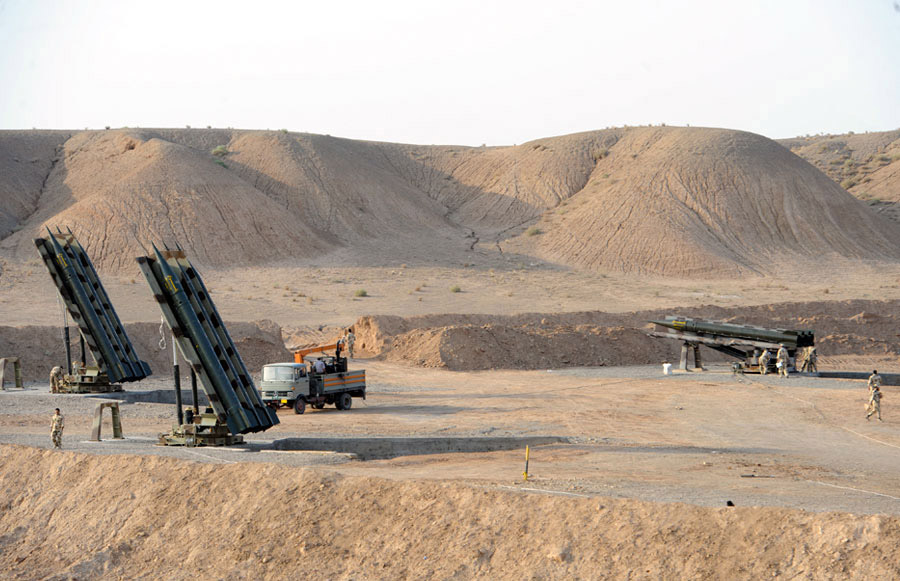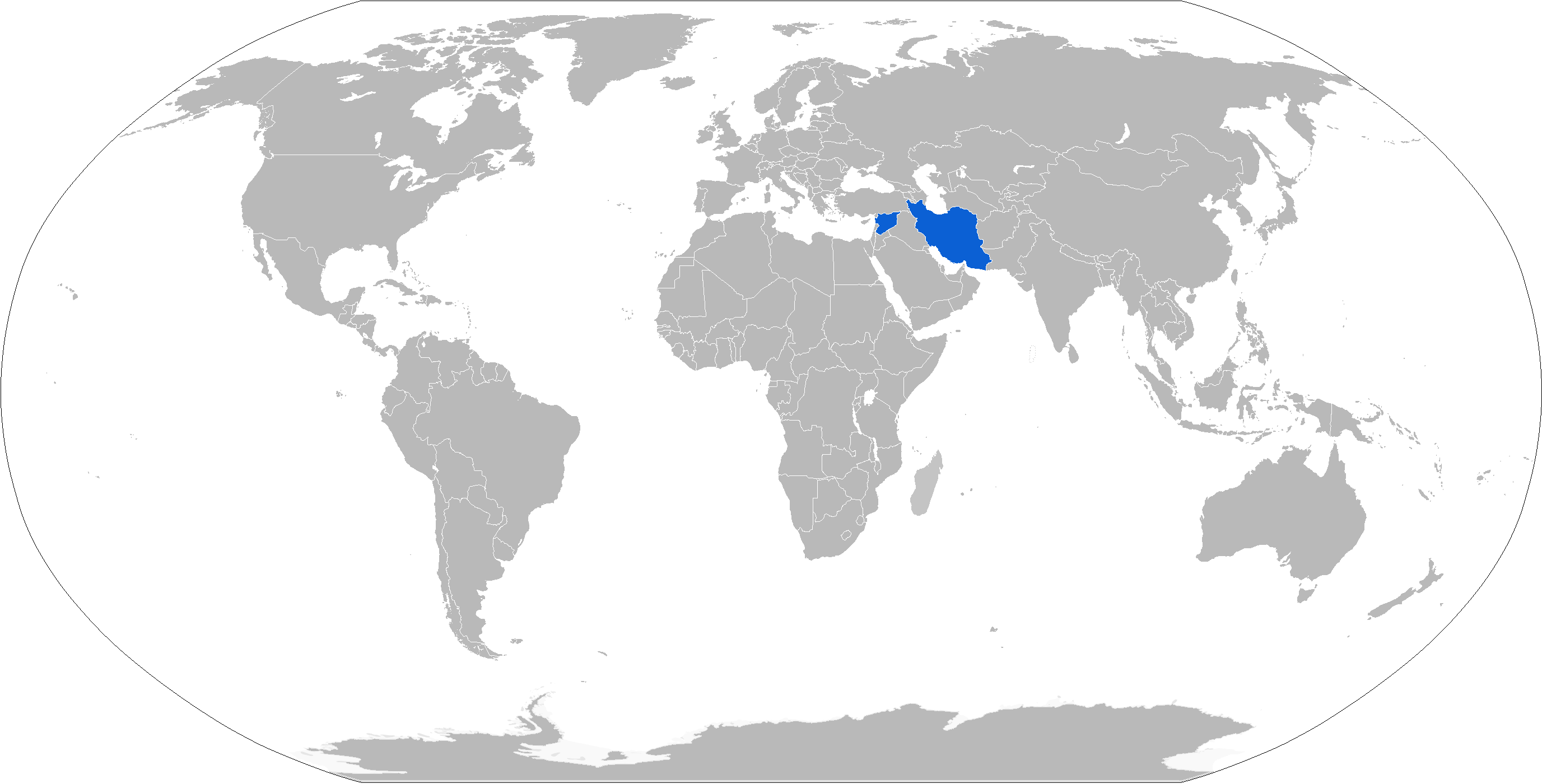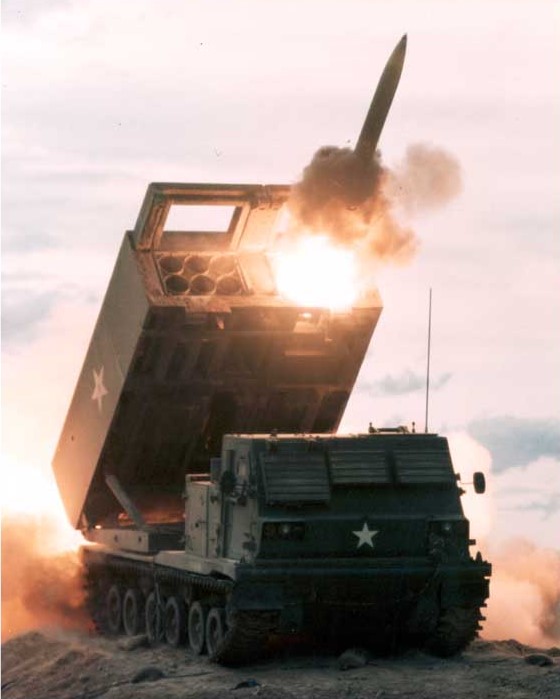|
Zelzal
Zelzal ( fa, زلزال-۱, meaning "Earthquake") is a series of artillery rockets developed by Iran. The series consists of: *Zelzal-1, with an estimated range of *Zelzal-2, with an estimated range of *Zelzal-3, with an estimated range of These rockets were developed by Hassan Tehrani Moghaddam following development the Shahab-1 and Shahab-2. See also *Aerospace Force of the Islamic Revolutionary Guard Corps *Armed Forces of the Islamic Republic of Iran *Defense industry of Iran *Equipment of the Iranian Army *Fateh-110 References Rocket artillery Artillery of Iran {{artillery-stub ... [...More Info...] [...Related Items...] OR: [Wikipedia] [Google] [Baidu] |
Zelzal-3
Zelzal-3 ( fa, زلزال-۳, meaning "earthquake") is an Iranian-made solid propellant guided artillery rocket with a range of 200 km. Cordesman, Anthony H. (2007)Lessons of the 2006 Israeli-Hezbollah War p. 11. It is an upgrade of the Zelzal-2 rocket with slightly improved range and was first shown to the public in 2007. A variant, the Zelzal-3B, has a smaller warhead and a range of 250 km. The shape and dimensions of the Zelzal-3 are nearly identical with previous versions except that the nosecone is cone shaped rather than the dome shaped Zelzal-2 and Zelzal-1. The Zelzal-3 has received little use as the much more accurate Fateh-110 missile was also developed from the Zelzal-2. A number of sources confuse the Zelzal-3 with the Shahab-3 ballistic missile. Operators * * Houthi movement, Houthis have a rocket they call the Zelzal-3, which they claim it is locally-made and not imported from Iran. See also * Zelzal-1 * Zelzal-2 * Fateh-110 * Military of Iran * Aeros ... [...More Info...] [...Related Items...] OR: [Wikipedia] [Google] [Baidu] |
Zelzal-2
Zelzal-2/Mushak-200 (Persian: زلزال-۲, meaning "Earthquake") is an Iranian unguided long-range artillery rocket. The Zelzal-2 is a 610 mm truck-launched rocket that has a payload of 600 kg and a range of about 200 km. Development of the Zelzal series began in 1990 and the Zelzal-2 was first shown in 1998. It is developed from the Zelzal-1 and was developed into the Zelzal-3. It has been exported to Syria, Hezbollah, and the Houthis, and has seen combat use in the Syrian Civil War and Yemeni Civil War. The missile is thought to be based on the Soviet 9K52 Luna-M missile. Operators * * * Hezbollah * Houthis See also * Aerospace Force of the Islamic Revolutionary Guard Corps * Armed Forces of the Islamic Republic of Iran * Defense industry of Iran * Equipment of the Iranian Army * Fateh-110 * Zelzal-1 * Zelzal-3 Zelzal-3 ( fa, زلزال-۳, meaning "earthquake") is an Iranian-made solid propellant guided artillery rocket with a range of 200 km. Cor ... [...More Info...] [...Related Items...] OR: [Wikipedia] [Google] [Baidu] |
Zelzal-1
Zelzal-1 ( fa, زلزال-۱, meaning "Earthquake-1") is an Iranian-made heavy artillery rocket with an estimated range of 160 km. at missilethreat.com It is believed to be owned by the and . The rocket received relatively little use but was the basis for the more successful artillery rocket. Users * *See also * |
Aerospace Force Of The Islamic Revolutionary Guard Corps
The Islamic Revolutionary Guard Corps Aerospace Force or Islamic Revolutionary Guard Corps Air and Space Force (IRGCASF; fa, نیروی هوافضای سپاه پاسداران انقلاب اسلامی, niru-ye havâfazây-e sepâh-e pâsdârân-e enghelâb-e eslâmi, officially acronymed NEHSA) is the strategic missile, air, and space force within the Islamic Revolutionary Guard Corps (IRGC) of Iran. It was renamed from the IRGC Air Force into the IRGC Aerospace Force in 2009. Aviation forces Most American public sources disagree and argue on which aircraft are operated by the AFAGIR. The Washington Institute for Near East Policy said in 2005 that " e backbone of the IRGCAF consists of ten Su-25 Frogfoot attack aircraft (including seven flown from Iraq to Iran during the 1991 Gulf War, kept airworthy with the help of Georgian technicians) and around forty EMB-312 Tucanos". The Washington Institute also said that the IRGCAF maintained thirty Y-12 and Dassault Falcon 20 li ... [...More Info...] [...Related Items...] OR: [Wikipedia] [Google] [Baidu] |
Fateh-110
The Fateh-110 ( fa, فاتح-۱۱۰ "conqueror"), also known as NP-110 is an Iranian solid-fueled surface-to-surface ballistic missile produced by Iran's Aerospace Industries Organization since 2002. It is single-stage, road-mobile and can carry high-explosive warhead up to 500 kg. It was developed into four generations successively improving range and accuracy. In the latest version, it has a range of 300 km and a "pinpoint accuracy" (a CEP below 10m). The Fateh-110 was developed from Iran's Zelzal-2 unguided artillery rocket essentially through adding a guidance system. The Fateh-110 is also license-built in Syria as the M-600. The missile has been used in the Syrian Civil War by Iran and Syria. In addition to its confirmed use by these two countries, it is widely reported that the Fateh-110 has been exported to Hezbollah in Lebanon. Development After the Iran–Iraq War, Iran found out that it needed an accurate short-range missile, as its Zelzal and Naze'at rockets ... [...More Info...] [...Related Items...] OR: [Wikipedia] [Google] [Baidu] |
Hassan Tehrani Moghaddam
Hassan Tehrani Moghaddam ( fa, حسن تهرانی مقدم) (29 October 1959 – 12 November 2011) was an Iranian military officer in the Aerospace Force of the Islamic Revolutionary Guard Corps and designer of Iran's ballistic missile project. He was the chief of the Army of the Guardians of the Islamic Revolutionary Guard Corps. He founded Iran's long-range missile program and sought the expertise and blueprint designs from North Korea in order to help develop Iran's missile technology. He designed the Shahab, Ghadr and Sejjil missiles with an operational range of more than 1,000–2,000 kilometres to target Israel. For these reasons he is regarded as the father of Iran's missile program. He was killed on 12 November 2011 in the Bid Kaneh explosion, at a military base belonging to the Islamic Revolutionary Guard Corps 25 miles west of Iran's capital, Tehran. Biography Tehrani Moghaddam was born on 29 October 1959 in Tehran. In 1977, he graduated from high school. In 1979, he ... [...More Info...] [...Related Items...] OR: [Wikipedia] [Google] [Baidu] |
Equipment Of The Iranian Army
This page includes weapons used by both the Ground Forces of the Islamic Republic of Iran Army and the Ground Forces of the Islamic Revolutionary Guard Corps. From 1925 to the Iranian Revolution in 1979, Iran was primarily equipped with Western hardware and equipment. Cases exist where Iran was supplied with equipment before it was even made standard in the country that developed it (for example the US F-14 Tomcat jet, and the British Chieftain tank). Primary suppliers included the United States, Britain, France, West Germany, Italy, Israel, and the Soviet Union. The post-revolution sanctions and the Iran–Iraq War had a dramatic effect on Iran's inventory of western equipment. Under the pressures of war, supplies were quickly exhausted and replacements became difficult to come by. The war forced Iran to turn towards Syria, Brazil and China to meet its short-term military needs. Initial developments in military technology were carried out with the support of China, North K ... [...More Info...] [...Related Items...] OR: [Wikipedia] [Google] [Baidu] |
Iran
Iran, officially the Islamic Republic of Iran, and also called Persia, is a country located in Western Asia. It is bordered by Iraq and Turkey to the west, by Azerbaijan and Armenia to the northwest, by the Caspian Sea and Turkmenistan to the north, by Afghanistan and Pakistan to the east, and by the Gulf of Oman and the Persian Gulf to the south. It covers an area of , making it the 17th-largest country. Iran has a population of 86 million, making it the 17th-most populous country in the world, and the second-largest in the Middle East. Its largest cities, in descending order, are the capital Tehran, Mashhad, Isfahan, Karaj, Shiraz, and Tabriz. The country is home to one of the world's oldest civilizations, beginning with the formation of the Elamite kingdoms in the fourth millennium BC. It was first unified by the Medes, an ancient Iranian people, in the seventh century BC, and reached its territorial height in the sixth century BC, when Cyrus the Great fo ... [...More Info...] [...Related Items...] OR: [Wikipedia] [Google] [Baidu] |
Shahab-2
The Shahab-2 ( fa, شهاب ۲, Ŝahāb 2, meaning "Meteor-2") is the successor to the Iranian Shahab-1 missile. It is based on the North Korean Hwasong-6 (modified version of the Hwasong-5, itself a modification of the R-17 Elbrus). On November 2, 2006, Iran fired unarmed missiles to begin 10 days of military simulations. Iranian state television reported "dozens of missiles were fired including Shahab-2 and Shahab-3 missiles. The missiles had ranges from 300 km to up to 2,000 km. ... Iranian experts have made some changes to Shahab-3 missiles installing cluster warheads in them with the capacity to carry 1,400 bombs." These launches come after some United States-led military exercises in the Persian Gulf on October 30, 2006, meant to train for blocking the transport of weapons of mass destruction. Variants Shahab is the name of a class of Iranian missiles, service time of 1988–present, which comes in six variants: Shahab-1, Shahab-2, Shahab-3, Shahab-4, Shahab-5, Shahab-6. S ... [...More Info...] [...Related Items...] OR: [Wikipedia] [Google] [Baidu] |
Artillery Rocket
Rocket artillery is artillery that uses rocket (weapon), rocket explosives as the projectile. The use of rocket artillery dates back to medieval China where devices such as fire arrows were used (albeit mostly as a Psychological warfare, psychological weapon). Fire arrows were also used in multiple launch systems and transported via carts. First true rocket artillery was developed in India by the Kingdom of Mysore. In the late nineteenth century, due to improvements in the power and range of conventional artillery, the use of early military rockets declined; they were finally used on a small scale by both sides during the American Civil War. Modern rocket artillery was first employed during World War II, in the form of the German Nebelwerfer family of rocket ordnance designs, Soviet Katyusha rocket launcher, Katyusha-series and numerous other systems employed on a smaller scale by the Western allies and Japan. In modern use, the rockets are often guided by an internal guiding syste ... [...More Info...] [...Related Items...] OR: [Wikipedia] [Google] [Baidu] |
Fars News Agency
The Fars News Agency is a news agency in Iran managed by the Islamic Revolutionary Guard Corps (IRGC), an armed wing loyal to Supreme Leader Ali Khamenei. While it describes itself as "Iran's leading independent news agency", it is widely described by Western news media to be a "semi-official" news agency of the Government of Iran. All its content is free content, Creative Commons licensed. History Fars News Agency was founded in 2003. In addition to Persian reporting, the agency also provides news in English, Turkish, Arabic, and Dari. Notable stories Interview with Egyptian president In June 2012, Fars released an interview with Egyptian President Mohamed Morsi in which Morsi is said to have told Fars that he wanted to restore ties with Iran and wanted to "review" the Egypt–Israel peace treaty. Morsi later disputed the authenticity of the interview. Fars responded by providing what it said was audio of the interview. Arabic newscaster Al Arabiya quoted unnamed experts ... [...More Info...] [...Related Items...] OR: [Wikipedia] [Google] [Baidu] |
Shahab-1
The Shahab-1 ( fa, شهاب ۱, Ŝahāb 1, meaning "Meteor-1") was the foundation of the short-range Iranian missile program. During the Iran–Iraq War, Iran purchased R-17 Elbrus missiles from Libya, Syria and North Korea (Hwasong-5). It is a close copy of Hwasong-5 (R-17). Iran began making the Shahab-1 sometime between 1985 to 1988. Iran's Shahab-1 is a short-range ballistic missile derived from the Scud-B, and has a maximum range of 300km (185 miles). Iran employed Shahab 1s extensively during the 1990s and early 2000s against Mujahidin-e Khalq Organization (MKO) camps in Iraq. Variants Shahab is the name of a class of Iranian missiles, service time of ''c.'' 1987–present, which comes in six variants: Shahab-1, Shahab-2, Shahab-3, Shahab-4, Shahab-5, Shahab-6. Gallery File:Shahab-3 Missle by YPA.IR 01 (cropped).jpg, Operational pre-launch File:Shahab-3 Missle by YPA.IR 02 (cropped).jpg, Lift-off (cropped) File:Shahab-3 Missle by YPA.IR 02.jpg, Lift-off File:Shahab-3 ... [...More Info...] [...Related Items...] OR: [Wikipedia] [Google] [Baidu] |



.jpg)



